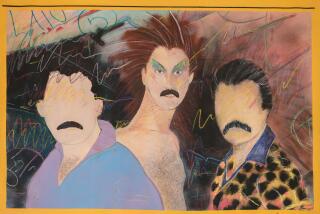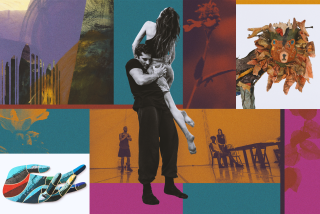Review: A welcome, belated L.A. debut for Wim Vandekeybus’ ‘Body’
- Share via
Belgian choreographer-filmmaker Wim Vandekeybus’ body of dance/theater works for his company Ultima Vez lends itself to evocative shorthand: There’s the one with the frozen shirt (“Les Porteuses de Mauvaises Nouvelles,” 1989), the one with the eggs (“Always the Same Lies,” 1990), the one with the climaxing woman (“Blush,” 2001) and dozens more.
This weekend’s two shows presented by the Center for the Art of Performance at UCLA brought a restaging -- and the Los Angeles premiere -- of his first work, the Bessie-Award-winning “What the Body Does Not Remember” (1987), a.k.a. the one with the bricks.
What a great programming coup to revisit Vandekeybus’ rootstock as well as to remedy L.A.’s heretofore weird angle on his career, a sporadic sampling that has featured the breadth of his work -- from pure dance/theater to film to film/dance hybrid -- but has never shown his most profound depths.
At its premiere decades ago, “What the Body Does Not Remember” stunned audiences with its edgy, erotic tone, its full-bodied pedestrian movement and its minimalist, cycling progressions.
In the six-section non-narrative work, Vandekeybus presented a male version of the great theatrical sculptures coming from the 1980s European dance/theater toolbox. His score was from Thierry De Mey and Peter Vermeersch, who also wrote for Anne Teresa de Keersmaeker’s “Rosas Danst Rosas.”
At Friday’s reprise at Royce Hall, on an enjoyably rangy group of dancers, “Body” stood up exceedingly well. Though its tone may have lost some bite, the work’s solid framework -- of incremental and abrupt delineations and progressions -- came to the fore.
From the opening, where two men walked onto the bare, side-lighted stage, then casually laid themselves in fetal positions on the floor, then rose again -- a map of verticality and horizontality was delineated.
The woman who appeared next, assuming control of the duo’s moves by stroking and slamming her hands against a miked tabletop, issued cues that kept the men relentlessly pinned down, until their final release. When the brick-throwing scene erupted, action careened into the airspace above the dancers with a heady vision of wild soaring and geometric weight.
Wandekeybus’ spatial relationships made for a magnificent restoration of “Body’s” singular, etched image of women standing with arms and legs outstretched rigidly, like Leonardo da Vinci’s Vitruvian man, while men ceaselessly frisked and hugged them.
The men squatted low -- groping a leg, nuzzling groins -- while the women’s responses were at eye level: glowering expressions, or a swatting arm, or a hand reaching to replace a piece of fallen hair. It’s a scene featured in “Spiegel,” the “greatest hits” collage that played Royce in 2008, but never has the effect as it does here.
Of the six sections, only one felt weak (the unconventional chair-sitter who sets off the conformist posse) and one seemed to scream for updated props (trade out at least one of those cloaking jackets for the veil of a cellphone?).
ALSO:
Wim Vandekeybus asks dancers to dig deep
‘Cinderella’: There’s always a party at Chez Rossini
Spring Arts Preview: Trisha Brown Dance Company among dance highlights
More to Read
The biggest entertainment stories
Get our big stories about Hollywood, film, television, music, arts, culture and more right in your inbox as soon as they publish.
You may occasionally receive promotional content from the Los Angeles Times.










